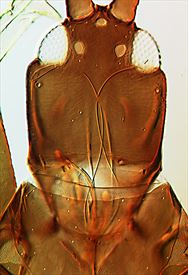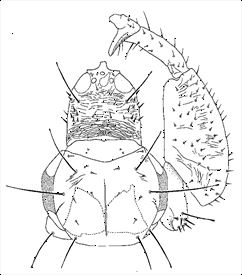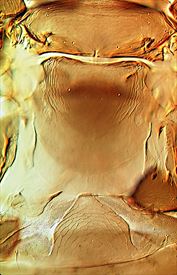Distinguishing features
Female fully winged or micropterous. Body brown; apex of antennal segment II and base of III paler; tarsi yellow; tibiae mainly yellow, but outer margins darker; fore wings and major setae pale. Head expanded behind eyes, cheeks constricted medially, faintly sculptured on lateral margins and at base; compound eyes bulbous, equal on dorsal and ventral; postocular setae wide apart, finely acute; maxillary stylets close together, retracted to compound eyes. Antennae 8-segmented, with short, fat sense cones, 3 on segment III, 4 on segment IV; segments IV–VII with distinct pedicels; VIII narrowed at base. Pronotum elongate, with a median longitudinal apodeme; posteroangular and epimeral setae long, finely acute, epimerals longest; basantra absent. Mesopresternum and anterior border of mesoeusternum eroded; metathoracic sternopleural sutures reaching halfway to coxae; metanotum sculptured laterally, with a median pair of acute setae. Fore tarsal tooth present. Fore wings with 16–18 duplicated cilia; major sub-basal setae acute, subequal. Pelta faintly sculptured, with small lateral lobes; tergite II eroded on lateral margins; tergites II–VII each with 1 pair of curved wing-retaining setae; tergite IX posteromarginal setae finely acute, about two-thirds as long as tube. Female microptera similar but mesonotum and metanotum transverse, fore wing lobe bearing at least 1 small seta.
Male microptera similar to female but smaller; sternite VIII with a small, reticulate, median pore plate; tergite IX posteromarginal setae S2 shorter. Large males with fore tarsal tooth larger, fore femora swollen, and sternites V–VII with lateral reticulations.
Related species
The genus Hoplothrips comprises about 130 species worldwide, of which 7 are recorded from New Zealand. Several of these appear to be endemic to this country, but corticis is from the northern hemisphere and orientalis is probably from Asia. H. kea is endemic to New Zealand, and is remarkable because of the shape of the head, the short antennal sense cones, and the curiously reticulate pore plate on sternite VIII of the males.
Biological data
Fungus feeding and collected from dead wood of Phyllocladus sp.
Distribution data
Known only from New Zealand (BR, MK).
Family name
PHLAEOTHRIPIDAE, PHLAEOTHRIPINAE
Species name
Hoplothrips kea Mound & Walker
Original name and synonyms
Hoplothrips kea Mound & Walker, 1986: 60
References
Mound LA & Walker AK (1986) Tubulifera (Insecta: Thysanoptera). Fauna of New Zealand 10: 1–140.



